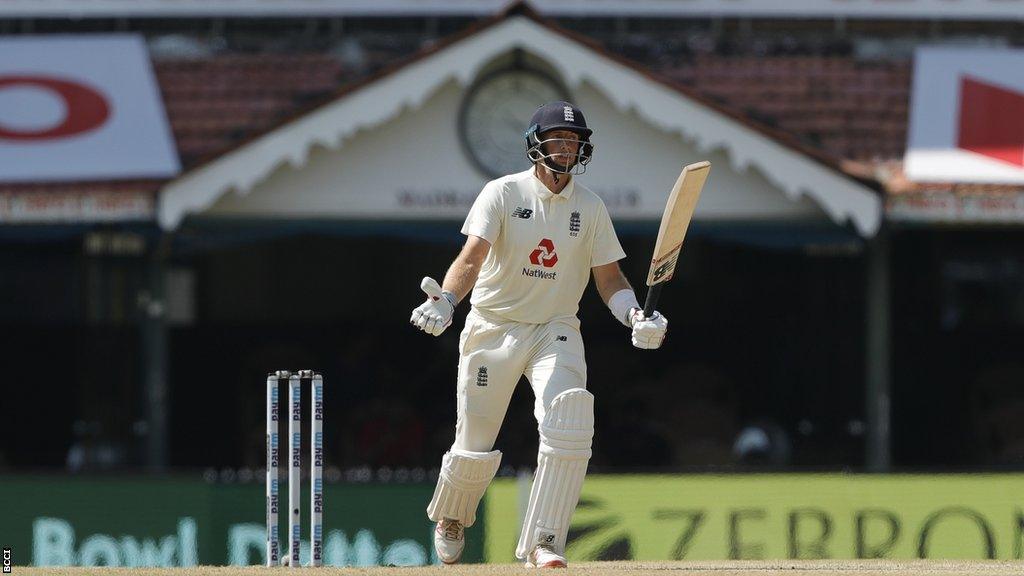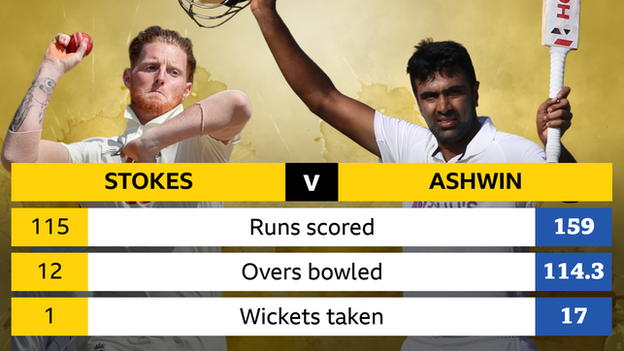India v England: How England can bounce back to win Test series
- Published

Joe Root, having made two double centuries and a hundred in his previous three Tests, scored six and 33 in Chennai
The more things change, the more they stay the same.
England have the familiar feeling of being hammered in a Test in India, this time on a strip causing the fiercest debate since Manchester United's cheese-and-onion third kit.
Captain Joe Root pointed out that the pitch was not the reason for England's 317-run defeat in Chennai - and his side still sit level at 1-1 with two Tests to play.
In fact, that was the first blemish of what was always likely to be a very tough winter. To have won 2-0 in Sri Lanka and be on terms with India is a more than satisfactory return thus far.
There are reasons to be cheerful, too. Still, for every cause for optimism, there are plenty more questions.
In the pink?
When it comes to unfamiliar conditions, England would have been more at home playing on the Moon than the dustbowl produced for the second Test.
That does not excuse England's performance - there were times when their batsmen were reckless and their spinners loose - but India are simply more adept, wise and experienced when it comes to succeeding when the ball turns.
There is some hope that things might be at least slightly different for the first of two Tests to come in Ahmedabad, with the third match in the series being played under floodlights and with a pink ball.
In the only day-night Test to have previously been held in India, albeit in Kolkata, not one wicket fell to a home spinner in their victory over Bangladesh. It is the only time India have won a home Test in such fashion.
England might get to Ahmedabad and find that little has changed, that pace bowling is again marginalised.
But if there is any encouragement for James Anderson and Stuart Broad (could they even play in the same team?), England must capitalise.
Rotation, rotation, rotation
England's policy of rest and rotation is designed to manage workloads in a year of 17 likely Tests and a Twenty20 World Cup, while also being mindful of players' wellbeing with so much time in 'bubbles'.
When even an Australian - limited-overs captain Aaron Finch - says England's method should be copied, there must be some merit in it.
However, it is a fact that the only two full-strength squads England have named this winter were for the T20 series in South Africa before Christmas and the current trip to India.

There is also the thorny issue of England players taking part in the Indian Premier League (IPL) but being rested from Tests.
Those aghast at such goings on must accept some realities - it is very difficult to deny players the IPL opportunity and, more often than not, the experience enhances their contribution to the England team.
England's player management plan is yet to be fully revealed. Perhaps, for example, some will take part in every Test this summer but sit out some white-ball matches.
On the other hand, there is the prospect of some players missing the June Test series against New Zealand in order to play in the final stages of the IPL.
It is understandable for England to want Eoin Morgan's T20 side at full strength for as many matches as possible before the World Cup, but could the two editions of the IPL have been seen as enough T20 cricket for those taking part?
On top of this, part of some players' periods of rest have been spent quarantining in Indian hotel rooms as they travelled home and back.
England's intentions have been admirable, but have they caused more problems than they have solved?
It is worth reiterating that results so far this winter have been good. The impact of the rotation policy will only be revealed in the fullness of time.
If England achieve their aims over the next year - the most significant being regaining the Ashes and winning the T20 World Cup - then it will be deemed a success. If not, some jobs may be on the line.
In a spin
After an initial storm, the issue surrounding Moeen Ali being rested for the final two Tests seems to have been put to bed.
It was clumsy for Root to say Moeen had "chosen" to go home, but he can be forgiven after four days of seeing his team flogged in Chennai.
However, there are consequences for the way it has been handled.
Whereas England have depth in batting, fast bowling and wicketkeeping, their spin reserves are shallow - not ideal on a tour of India.
Even though England knew of the plan for Moeen to go home after the second Test, they still picked him ahead of Dom Bess, who was dropped after playing in the previous nine matches.
With Jack Leach almost certain to play, England are also likely to turn back to Bess, who now knows that Moeen was asked to stay on.
It will take some delicate man-management of a young bowler set to be thrown back into the very thick of the action.
Five into three
If Zak Crawley recovers from a wrist injury, Ahmedabad will be the first occasion in the winter where England have a genuine decision to make on their top three.
For various reasons, they have not had Crawley, Dom Sibley, Rory Burns, Jonny Bairstow and Dan Lawrence available at the same time.
Of the five, Sibley seems nailed on to open after an 87 in the first Test, leaving the rest competing for two spots.
From incumbents Burns and Lawrence, number three Lawrence is most vulnerable.
If he is replaced, Bairstow is an excellent player of spin and outscored Crawley in Sri Lanka, but it is only five innings ago that Crawley made a dazzling 267 against Pakistan.
So far this winter, England's huge scores have built on the stellar form of Root. When Root returned little in Chennai, England failed to post a cumulative 300 runs across their two innings for the first time since 1995.
The skipper needs help.
Can Stokes solve Ashwin conundrum?
In July, Ben Stokes was ranked as the third best batsman in the world, but would go on to play only three more Test innings before the tour of India through a combination of compassionate leave and being rested.
On his return in the first Test, all looked right as he was compiling 82 in the first innings. Since then he has managed only 33 in three knocks, falling to Ravichandran Ashwin on each occasion.

Ben Stokes and Ravichandran Ashwin's returns with bat and ball in the first two Tests
Indeed, Ashwin is the question Stokes has failed to answer most in his Test career. The masterful off-spinner has dismissed Stokes on 10 occasions, four times more than any other bowler.
In the first innings of the second Test, Stokes was blameless in being bowled by an almost unplayable delivery, but he was suffocated in the second, eventually offering a tame bat-pad catch and leaving with a shake of the head.
In bowling only two overs in the second Test - Root was adamant that was for tactical reasons rather than fitness - Stokes was a figure on the edge of the action. He even dropped Ashwin, who went on to complete a century.
It is hard to imagine England getting anything from this series without Stokes making some sort of contribution.
If his bowling is to remain surplus to requirements, then his influence must come with the bat, and that means finding a way to conquer Ashwin.

Rugby Union Weekly: Another huge weekend in the Six Nations is unpacked by the boys
1 Xtra's Money Moves: Top tips on a positive approach to managing your finances
